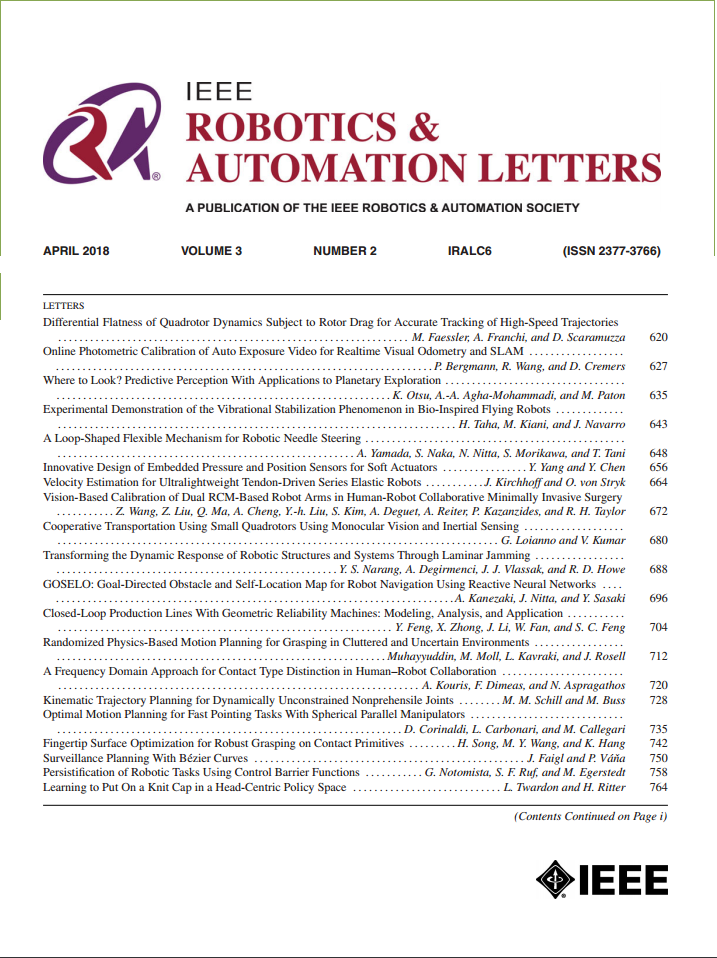三维动态环境下机器人辅助可操纵斜尖针路径规划
IF 4.6
2区 计算机科学
Q2 ROBOTICS
引用次数: 0
摘要
在微创手术(MIS)中,如何在不与解剖障碍物发生碰撞的情况下达到目标的准确性是最关键的方面。然而,由于组织环境的非完整约束和针头插入过程中的动态行为,规划合适的路径是一项重大而复杂的挑战。为了解决上述挑战,本研究引入了一种新的机器人辅助柔性斜尖针在组织区域内的路径规划方法。该路径规划器的主要贡献在于它能够整合动态3D环境,其中包含多个目标和不同位置的障碍物。在文献中,有几种方法来规划组织区域内的无障碍路径。其中,基于快速探索随机树(RRT)的路径规划方法具有计算时间短、适合高维空间的优点。该算法建立在RRT技术的基础上,利用贪婪概念对其进行增强,以处理多个动态目标。此外,还进行了广泛的模拟和实验研究,以证明所提出方法的有效性,以期将来进行临床试验。对所提出的路径规划方法进行了统计分析,重点是寻找可行路径的计算时间和规划轨迹的长度。本文章由计算机程序翻译,如有差异,请以英文原文为准。
Path Planning for Robot Assisted Steerable Bevel-Tip Needle in 3D Dynamic Environment
In Minimally Invasive Surgery (MIS), achieving target-reaching accuracy without colliding with anatomical obstacles is the most crucial aspect. However, due to the non-holonomic constraints within the tissue environment and the dynamic behavior during needle insertion, planning an appropriate path presents a significant and complex challenge. In order to address the above-mentioned challenges, this study introduces a novel path-planning approach for a robot-assisted flexible bevel-tip needle within the tissue region. The primary contribution of this path planner is its ability to incorporate a dynamic 3D environment, which includes multiple targets and obstacles with varying locations. In the literature, there are several methods for planning obstacle-free paths within the tissue region. Among them, the Rapidly-Exploring-Random-Trees (RRT) based path planner methodology is advantageous due to its reduced computational time and suitability for high-dimensional spaces. The proposed algorithm builds upon the RRT technique, enhancing it with a greediness concept to handle multiple dynamic targets. Additionally, extensive simulations and experimental studies have been conducted to demonstrate the efficacy of the proposed method, with a view toward future clinical tests. Statistical analysis of the proposed path planner methodology has also been performed, focusing on computational time for finding feasible paths and the length of the planned trajectory.
求助全文
通过发布文献求助,成功后即可免费获取论文全文。
去求助
来源期刊

IEEE Robotics and Automation Letters
Computer Science-Computer Science Applications
CiteScore
9.60
自引率
15.40%
发文量
1428
期刊介绍:
The scope of this journal is to publish peer-reviewed articles that provide a timely and concise account of innovative research ideas and application results, reporting significant theoretical findings and application case studies in areas of robotics and automation.
 求助内容:
求助内容: 应助结果提醒方式:
应助结果提醒方式:


